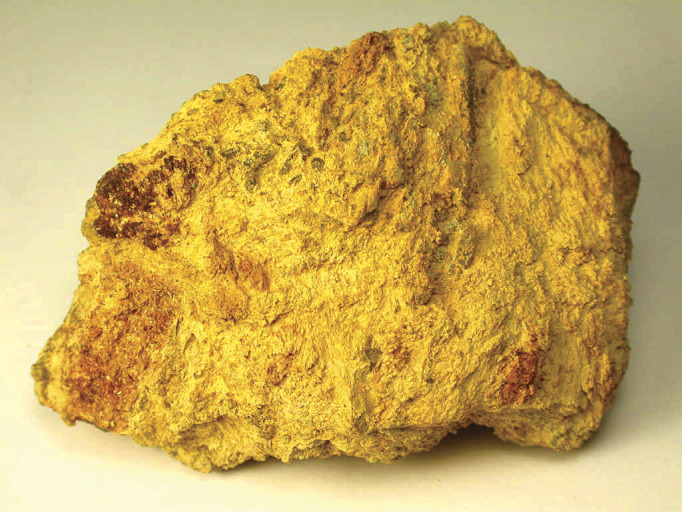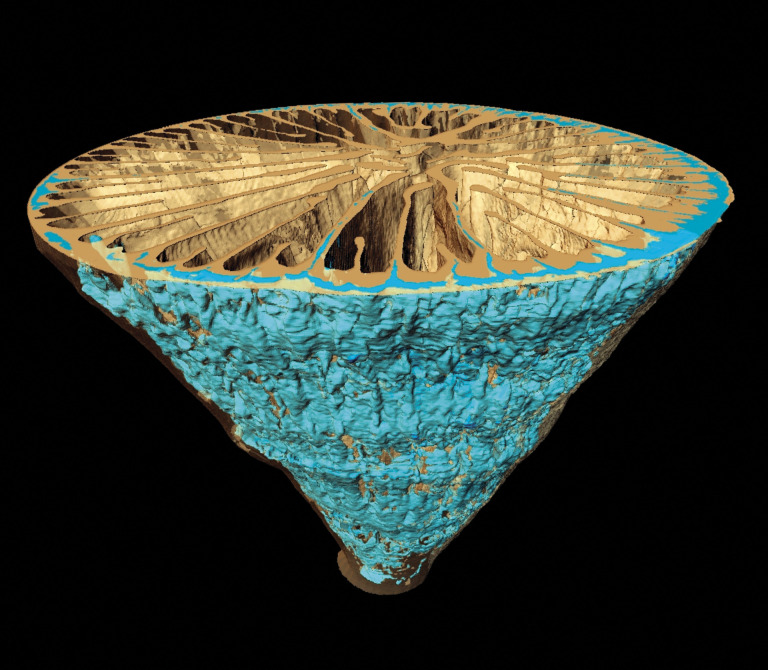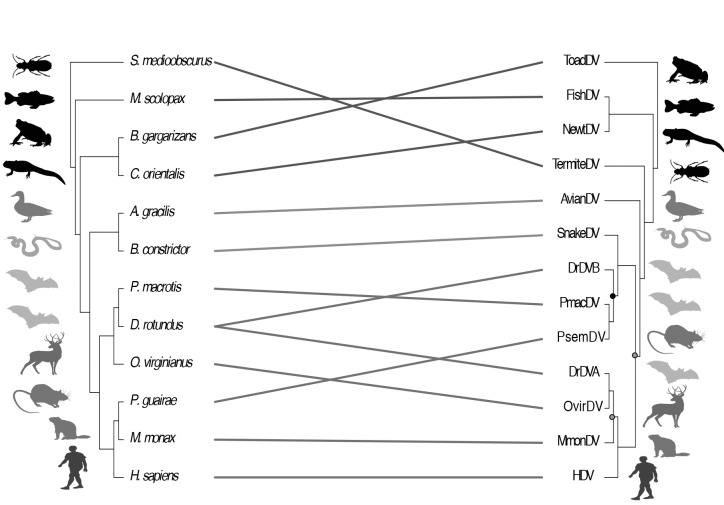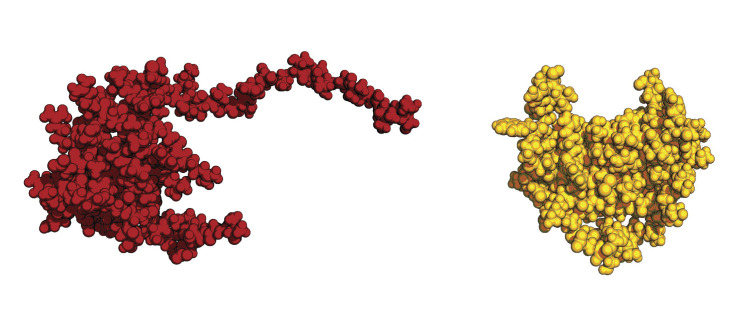ENVIRONMENTAL SCIENCES

Plumbojarosite, an insoluble lead–iron hydroxysulfate mineral. Image credit: Wikimedia Commons/John Sobolewski (JSS), licensed under CC BY 3.0.
Reducing lead bioavailability in soil
Childhood exposure to lead can lead to long-term adverse health effects. A significant source of lead exposure in children is contaminated soil and dust. Because of the expense and complexity of removing and replacing contaminated soil, Ranju Karna et al. examined the feasibility of reducing the bioavailability of soil-borne lead by altering its physiochemical properties in situ. The authors converted soil lead into plumbojarosite, an insoluble lead–iron hydroxysulfate mineral, by addition of iron sulfate and sulfuric acid. X-ray absorption spectra of contaminated soils before and after treatment indicated that more than 90% of soil lead was converted to plumbojarosite after 8 hours of treatment. Lead remained in plumbojarosite after post-treatment neutralization of soil pH. To measure the relative bioavailability of soil lead, the authors fed mice diets containing untreated or treated lead-contaminated soils. Mice exposed to treated soils had at least 90% lower lead concentrations in blood and bone than mice exposed to untreated soils. According to the authors, in situ plumbojarosite formation could be a cost-effective method for remediating soil lead contamination and preventing exposure in children. — B.D.
PNAS e2020315117 (2021)
EVOLUTION
X-ray computed tomography of Paraconotrochus antarcticus, showing the calcitic inner (blue) and aragonitic outer (semitransparent beige) skeletons.
Modern scleractinian coral with two-component skeleton
Modern scleractinian corals, the dominant reef-building corals on Earth, are thought to produce skeletons exclusively from the calcium-carbonate polymorph aragonite. This conclusion is supported by a 240-million-year fossil record with only one counterexample, namely Coelosmilia, a coral from the Cretaceous period with a skeleton composed entirely of calcite. Jarosław Stolarski et al. report that Paraconotrochus antarcticus, asymbiotic scleractinian coral found commonly in the Southern Ocean around Antarctica, has a skeleton with an inner structure made of high-magnesium calcite surrounded by an outer structure composed of aragonite. The P. antarcticus skeleton also shares features with Coelosmilia, such as microstructures that suggest a close phylogenic relationship between the two. Phylogenomic analysis indicated that P. antarcticus likely diverged early within one of the two major coral clades, around 116 million years ago, during the Cretaceous. The findings suggest that scleractinian corals belong to the group of marine organisms that evolved the ability to form structures composed of two minerals. According to the authors, the geographic isolation of the Southern Ocean may favor other organisms with preserved ancient traits. — T.J.
PNAS e2013316117 (2020)
ENVIRONMENTAL SCIENCES
Forced labor in global fisheries
Forced labor in fisheries around the world has been documented, but the extent to which it occurs remains unclear. Gavin McDonald et al. combined machine learning with satellite-monitoring data from 2012 to 2018 for more than 16,000 industrial fishing vessels, including long-liners, trawlers, and squid-jiggers. The authors also reviewed investigative reports published between 2015 and 2019 by Greenpeace, the Environmental Justice Foundation, Oceana, and The New York Times about instances of forced labor case accounts detailing observable vessel behavior from vessel-monitoring data. Additionally, the authors consulted experts from six nonprofit organizations about observable vessel behavior to identify suspected forced labor. Compared with vessels not using forced labor, long-liners and trawlers at a high risk of forced labor traveled further from ports and shores, fished more hours per day, and had fewer voyages but longer voyage durations. Between 57,000 and 100,000 crewmembers working on 2,300–4,200 high-risk vessels potentially represented forced labor. Fisheries with the largest number of high-risk vessels were Chinese squid-jiggers and Chinese, Japanese, South Korean, and Taiwanese long-liners. High-risk vessels predominantly visited Africa, Asia, and South America. The findings suggest that forced labor is widespread in global fisheries, according to the authors. — M.S.
PNAS e2016238117 (2020)
PHYSICS
Confocal microscopy on ellipsoidal core–shell particles reveals clusters in liquid glass.
Ellipsoidal colloids form novel liquid glass state
Studied for more than a century, colloidal suspensions are found commonly in nature and exploited for a wide range of technologies. In particular, researchers have focused on suspensions of spherical colloids at the so-called glass transition: a nonequilibrium transition, accompanied by dramatic changes in transport properties, that occurs when the particle density exceeds a threshold concentration. Based on computer simulations and a theoretical analysis, Jörg Roller et al. use confocal laser scanning microscopy to track the positions and orientations of custom core–shell-particle ellipsoid colloid suspensions as the volume fraction increases to the glass transition. The authors show that ellipsoidal colloids transition through a previously unreported state of matter that reflects their particles’ shape, a novel liquid glass state in which rotations are fixed but translations remain fluid. With detailed image analysis, the authors describe the formation of previously unreported nematic precursor clusters, which constitute characteristic structural elements of the liquid glass state and prevent the formation of a nematic liquid crystal. According to the authors, the findings provide details about how local structures facilitate phase transitions and can inform future research into emerging technologies. — T.J.
PNAS e2018072118 (2021)
PSYCHOLOGICAL AND COGNITIVE SCIENCES
Self-control and midlife aging
The relationship between self-control and aging is unclear. To determine whether self-control in childhood can predict the course of aging, Leah Richmond-Rakerd et al. followed a cohort of 1,037 individuals born in New Zealand between 1972 and 1973 from their birth to age 45 via the Dunedin Longitudinal Study. Self-control was measured from ages 3 to 11 years via assessments by teachers, parents, researchers, and the children themselves. Assessments included aspects such as high impulsivity, low frustration tolerance, and low persistence in reaching goals and completing tasks. Assessments of midlife aging were carried out at age 45 years via physical exams, brain scans, and interviews. Individuals who exhibited high self-control in childhood physically aged slower, showed fewer signs of brain aging, and better managed health, financial, and social demands than individuals who exhibited low self-control in childhood. High self-control in childhood was also associated with increased social connectivity and high test scores related to health and financial knowledge. High IQ and advantaged childhood circumstances did not account for links between self-control and aging. Furthermore, self-control in adulthood was associated with aging outcomes, even after accounting for self-control in childhood. The findings suggest that programs to increase self-control in children might extend both the length and quality of life, according to the authors. — M.S.
PNAS e2010211118 (2021)
ECOLOGY
Cophylogeny shows connections between the deltavirus phylogeny and host tree.
Habitat loss, harvest, and mammal diversity
Biodiversity is declining worldwide, but little is known about the human-related factors with the strongest adverse impacts on functional diversity. Jedediah Brodie et al. generated a database that captures the likely effects of human-related factors on terrestrial and freshwater mammal species on the International Union for Conservation of Nature Red List of Threatened Species. The authors also analyzed a dataset of mammal functional traits—such as diet, to characterize diversity in terms of ecological functions—and global range maps for mammal species. The analysis revealed that habitat loss and harvest, through activities such as hunting, poaching, and snaring, may be the most important drivers of biodiversity loss worldwide. Herbivores are disproportionately likely to be in decline due to harvest, whereas fruit-eating mammals are particularly likely to be in decline because of harvest and habitat loss. In highly biodiverse regions such as South America and Southeast Asia, declines in functional diversity associated with habitat loss and harvest are greater than that expected if species losses were random. Moreover, habitat loss and harvest in the most biodiverse regions of the world may disproportionately affect species that play unique functional roles in their ecosystems. According to the authors, conservation efforts should target the most impactful human activities in specific geographic regions to protect Earth’s remaining biodiversity. — J.W.
PNAS e1921849118 (2021)
EVOLUTION
Delta viruses and shifting mammalian host species
The hepatitis delta virus (HDV) exploits the hepatitis B virus to spread within and between hosts. In humans, HDV exacerbates liver disease and is the only known satellite—a virus-like agent that requires both a host and a virus to complete its life cycle. To explore the mysterious evolutionary origins of this unique virus, Laura Bergner et al. used large-scale data mining, coevolutionary modeling, and field studies in bats. The authors analyzed 96,695 RNA sequence datasets from 403 species across 24 mammalian orders. Five deltaviruses were detected in three mammalian orders, including bats, rodents, and even-toed hoofed animals. Deltaviruses exclusively infect non-human mammals in North and South America, contradicting the previously proposed hypothesis that HDV originated in the Old World. Phylogenetic analysis suggested that deltaviruses have diversified genetically over evolutionary timescales by shifting mammalian host species. Analysis of saliva samples from bats revealed that deltaviruses are transmitted between species on ecological timescales. Taken together, the findings point toward the possibility of future cross-species transmission of deltaviruses to humans or other mammalian hosts, according to the authors. — J.W.
PNAS e2019907118 (2021)
BIOCHEMISTRY
XCL1 is the rare example of a protein with two different active structures, below. Researchers are starting to reveal how it evolved. Image credit: Acacia Dishman/Medical College of Wisconsin.
Study reveals evolutionary origins of fold-switching protein
Posted on January 8, 2021
Amy McDermott
Most proteins are thought to fold into a single active shape. But the human immune protein XCL1 is a rare breed that can switch back and forth between two different structures, each with its own function. A recent study in Science elucidates the evolutionary history of XCL1, concluding that it evolved from an ancestor with a single active conformation about 350 million years ago. The authors used a combination of biochemistry and nuclear magnetic resonance (NMR) to synthesize XCL1’s ancestral proteins in the lab, and to determine when the protein’s ancestors became metamorphic. Continue Reading⇒






